
About Ladakh Union Territory
Nestled among the Himalayan ranges, Ladakh is one of the highest inhabited regions
in the world. It is the northernmost part of India, sharing borders with China (Tibet
Autonomous Region) in the east, Pakistan Occupied Kashmir in the west and Xinjiang
Uyghur Autonomous Region in the north. It is situated in the rain shadow of Trans-Himalayas
where annual precipitation is 100mm. Population density is five persons per square
kilometre. It consists of two districts: Leh and Kargil. Ladakh become a Union Territory
on October 31, 2019 when the Jammu & Kashmir Reorganisation Act was passed in the
Parliament of India on August 5, 2019. It comprises of two districts; Leh and Kargil.
Major Problems
- Small landholding of 0.5 ha per family and short agriculture season of six months
- Lack of value chain development of apricots, vegetables and wools is hampering rural
employment and economy
- Lack of harvest and post-harvest technologies cause high wastage (>50%) in apricots
- Agriculture is less remunerative for small and marginalised farmers without crop
diversification and marketing linkages
- Farmers are hesitant to adopt new techniques, technologies and high value crops
due to lack of knowledge and access to infrastructures
- Climate Change is causing natural glaciers in recede faster than before posing a
big threat and challenge to local farmers
- Manual operation leading to high labour intensity and danger to livestock when temperatures
drop to sub-zero in winters
- Adverse climatic conditions leading to limited vegetable cultivation particularly
in winter months resulting in high dependency on imported food grains
- Low yield of crops due to limited access to water for irrigation and infrastructures
Activities undertaken by Tata Trusts and Himmotthan Society in 2016-19
In the last four years (2016 to 2019), Tata Trusts and Himmothan Society has reached
4,000 families in 40 villages spread across five administrative blocks of Leh district.
- Two Farmer Producer Organisations are formed, one for Apricot and another for Vegetables
with more than 300 shareholding members, which will increase to 600 and more in
the next coming years
- 4.5 tonnes of green peas, 2.9 tonnes of kidney bean, 20 kg of onion, 30 kg plus
12,000 seedlings of watermelon and 0.4 kg of tomato seeds were distributed to 1,000
farmers for demonstration, along with 1600 square metre of black plastic mulch for
cultivation of watermelon crop
- 55 passive solar greenhouses are constructed, producing 16.5 tonnes of vegetables
annually
- 7 artificial glacier, 5 diversion-based irrigation canals and 3 water reservoirs
were constructed, repaired and renovated catering to irrigation needs to 654 families
and supplementing irrigation over 1,018 acres of agricultural land
- Apricot value chain development: 276 solar apricot dryers and 1036 harvesting nets
are demonstrated in 11 villages
- Potato value chain development: 35.5 tonnes of improved potato seeds are distributed
to 80 farmers in Nang, Skakmo and Umla villages. Six cellars were also constructed
potato
- Women empowerment through artisan skill development: 460 women artisans from 55
Self Help Groups from 17 villages were trained in knitting
Current projects of Himmotthan Society in Ladakh
At present, Himmotthan Society has eight ongoing projects in Ladakh which are co-funded
by various agencies such as Tata Trusts, NABARD, NSTFDC, Sustain+ and Ministry of
Tribal Affairs. These projects were approved at different time of the year and in
some cases, desired results couldn’t be achieved because of short working season.
1. Crops Diversification for Enhancement of Rural Farmer’s Income in Leh District
(2019-22) – National Bank for Agriculture and Rural Development (NABARD)
Some of the key objectives of the project are to cover 150 acre of land under high
value cash crop and to enhance crop productivity through mulching technology, encourage
farmers for seed production for self-consumption and develop farmers and consumers
interface through FPO for developing market linkages for fresh and value added vegetables.
The project aimed at reaching 400 farmers in 20 villages of Leh district.
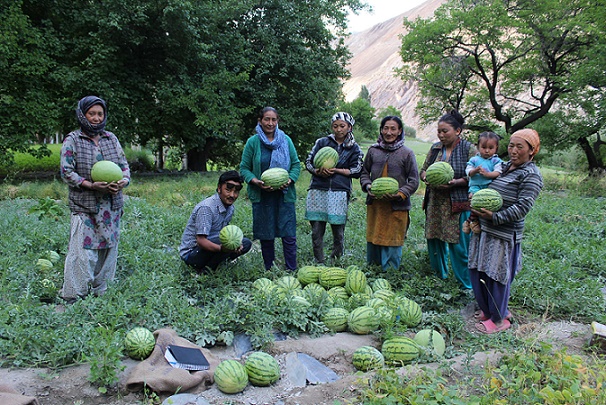
Harvesting of watermelon by SHG members in Takmachik
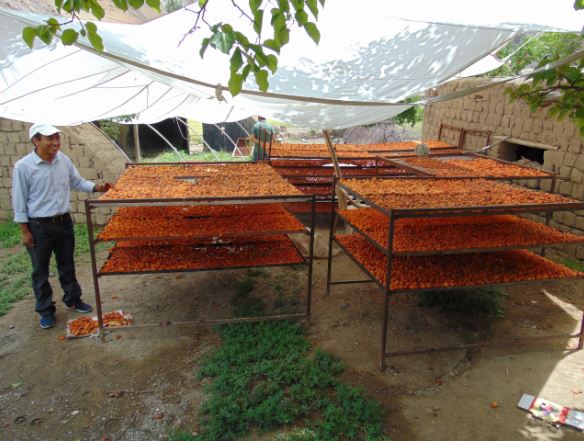
Apricot drying under parachute tent
2. Formation of Apricot Farmer Producer Organisation in Sham valley of Leh district
(2019-22) - National Bank for Agriculture and Rural Development (NABARD)
Project aims to form and strengthen two Farmers Interest Group (FIG) from each of
the 15 villages and aggregate in FPO with 300 members; post-harvest handling, agro-processing
and sustained institutional marketing of apricot value added product; to facilitate
expansion, growth and profitability of the FPO business through credit access and
marketing linkages.
3. Formation of Vegetable Farmer Producer Organisation in Leh district
(2019-22) - National Bank for Agriculture and Rural Development (NABARD)
Key objectives are to form and strengthen at least two Farmers Interest Group (FIG)
from each of 15 villages and aggregate in FPO with 300 members; to develop and improve
their overall business management skills of working with the suppliers (farmers)
and to improving service products, delivery and efficiency to the suppliers; to
demonstrate improvement in managing business operations and management and to facilitate
expansion, growth and profitability of the FPO business through input supply, credit
access and marketing linkages.
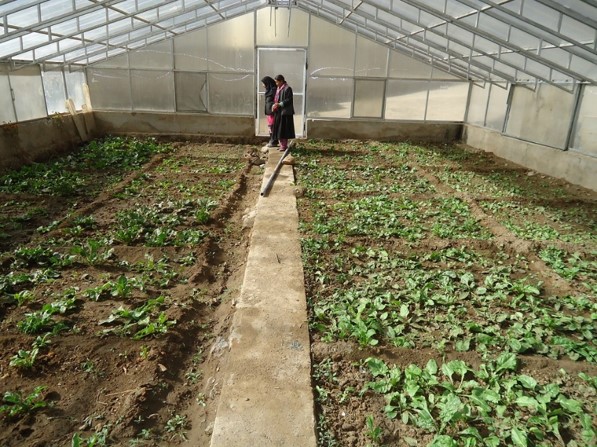
Polycarbonate greenhouse run and managed by women SHG in Phey village of Leh District
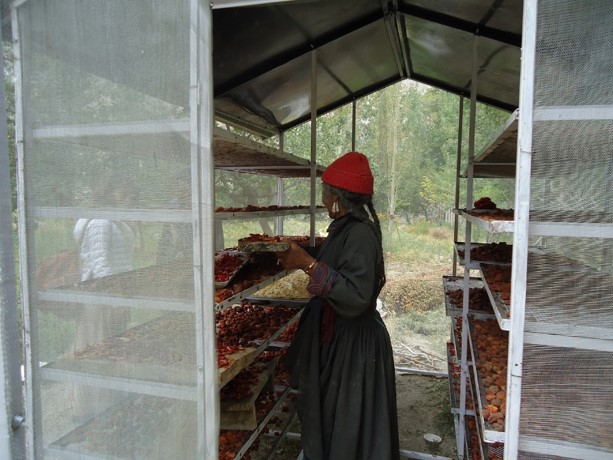
Solar apricot dryer in Achinathang village
4. Promoting decentralized renewable energy solutions to enable rural livelihood
(2019-20) - Sustain+/ Collectives for Integrated Livelihood Initiatives (CInI)
The overall objective of the project is to promote decentralised renewable energy
(DRE) enabling livelihood activities and empower the tribal community. The project
will directly benefit 100 households (500 beneficiaries) belonging to scheduled
tribe category across eight villages in three clusters (or four administrative blocks)
of Leh district. Indirectly, it will bring benefit to more than 200 families through
these demonstration units, knowledge sharing, technological transfer, sharing of
resources and project outputs. Some of the key activities are solar lambing shed,
improved solar greenhouse, solar apricot dryer, solar lift-based irrigation and
wasteland development, solar operated sheep shearing machine and capacity building
programme.
5. Changthang Livestock and Wool Craft Promotion
(2019-22) – National Scheduled Tribes Finance and Development Corporation (NSTFDC)
The project aims to improve the quality of life and incomes from improved livestock
wool craft based interventions for 300 families in three villages of Leh district.
Key objectives are promotion of Wool Craft Based Enterprise in three villages of
Nyoma block (Nyoma, Mudh and Hanley) taking the value chain approach; community
owned wool based enterprises will be set up and 50 craftsperson and nomads will
be trained in use of better livestock management practices and craft tools.
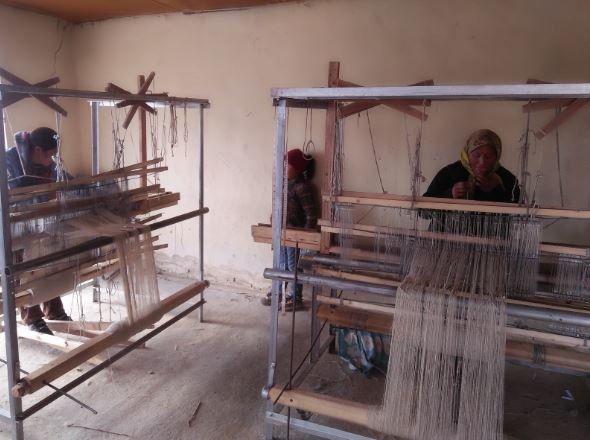
Weaving training
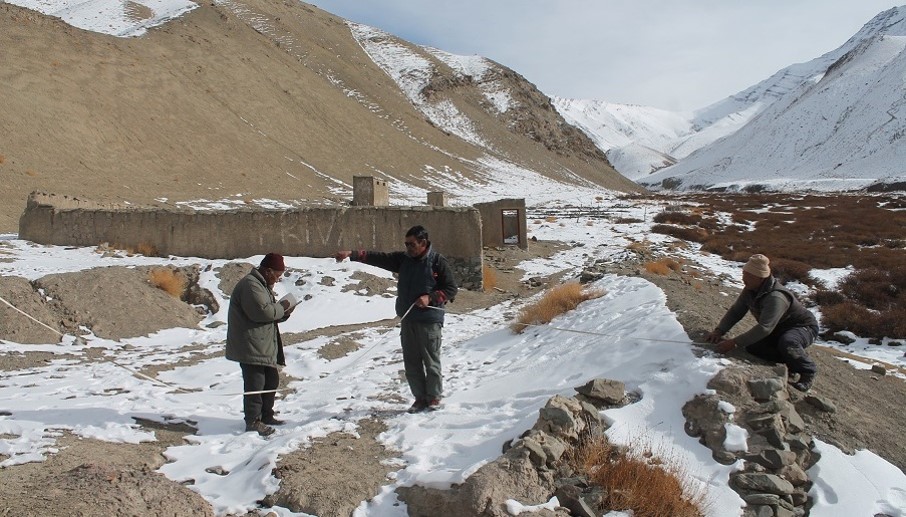
Project team making assessments for renovation of water reservoir in Rumbak village of Leh district
6. Centre of Excellence for Research and Documentation of Agro-processing and Livelihoods
in Tribal Areas of Leh district
(2019-22) – Ministry of Tribal Affairs (MoTA)
The project aimed studying the traditional and improved farming practices of tribal
population through action research and documentation. It is also aimed at promoting
agriculture and allied activities by participatory action research programme for
agro-processing and market linkages. It will cover 1,500 households in 20 villages
of Leh district. Key activities are to establish a Centre of Excellence for agro-processing,
market studies, training and capacity building of tribal farmers and research and
documentation of their agrarian lifestyle.
7. Springshed based Watershed Development Fund in Sakti village of Leh district
(2019-22) – National Bank for Agriculture and Rural Development (NABARD)
The project aims at promoting innovative ideas of water conservation and distribution
in Tagar and Taknak Halqa Panchayats of Sakti village. The creation of artificial
glaciers combined with existing traditional irrigation channels will support optimum
utilisation of water resources. Augmenting the water resources through creation
of water harvesting and irrigation infrastructure will encourage the farmers to
farm their lands and also bring more land under cultivation for crops production
and orchards development. The project will directly benefit 370 households with
a total population of 1718 supplying additional irrigation to 285 ha of agricultural
land during the critical sowing season.
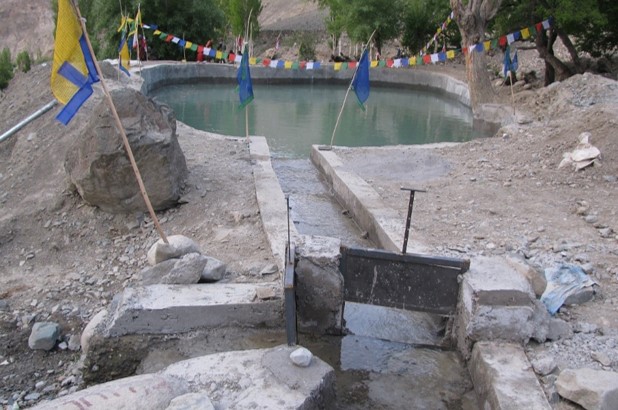
Water reservoir in Takmachik village
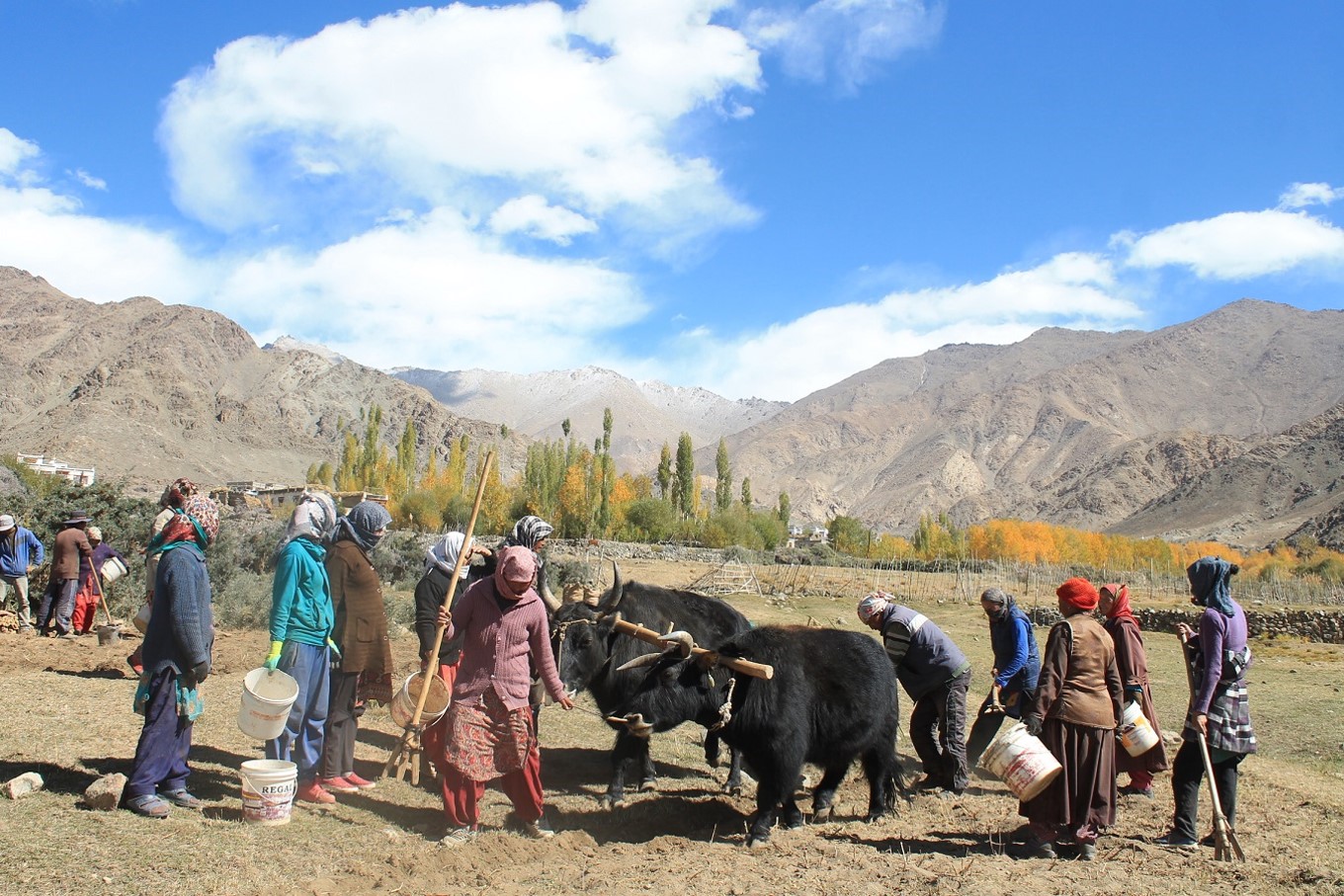
Ploughing the field
8. Leh Livelihood Initiative Phase 2
(2020-24) – Tata Trusts
The overall aim is to improve the living condition of 4000 families living in 40
rural villages spread across six administrative blocks of Leh and Kargil districts
in Ladakh Union Territory by promoting land-based economy and social enterprises
that will ultimately lead to sustainable development in the region. Key objectives
are value chain development of three key products i.e., apricots, wools and vegetables;
formation and nurturing of 60 farmer groups, two Farmer Producer Organisations (FPOs)
and establishing self-sustainable social enterprises and Centre of Excellence (CoE);
to ensure assured irrigation to small-scale farmers through innovations, appropriate
technologies and people’s participation and to promote decentralised renewable energies
and solutions for overall economic upliftment of tribal farmers and nomads.